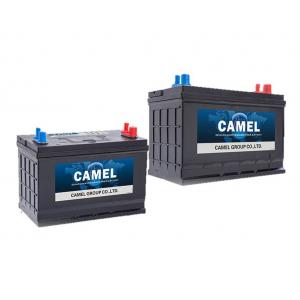

Add to Cart
Camel Brand 12V Lead-acid Maintenance Free Marine Battery
The deep cycle marine battery is the ideal for powering the motor as well as other electric battery-powered accessories, including radio/ audio systems, windlass, depth finders, fish locators, and other appliances. Deep cycle batteries are specifically designed to discharge slowly over an extended duration. They’re also able to withstand several hundred charging cycles. Deep cycle marine batteries are more corrosion resistant after many charge/discharge cycles.
Product Features
High Performance
Lead Acid Marine Battery is a high performance, high quality marine
battery. It has the characteristics of large capacity and high deep
circulation capacity.
Overcharge and Discharge Resistant
Lead Acid Marine Battery is also resistant to overcharge and high
rate discharge as well as vibration resistance.
High Deep Cycle Capability
Marine batteries are designed for deep cycle service with visible
plates and separators.
Safe and Reliable
This marine battery is designed to handle the harsh environments of
fishing boats, and fire departments. Can bear the weight of lead
plate, provide high rate discharge current, bring you a safe and
reliable marine power supply system!
Product Model
| Type | Part No. | CCA (-18℃) | RC(min) | Dimensions(mm) L*W*H | Terminal (Layout/Type) | Hold Down | Weight (kg) |
| MRV24DP | 90D26 | 625 | 157 | 256*170*246 | 1/Marine | B00 | 20.9 |
Applications
Deep cycle marine batteries are specially designed for starting, lighting and communication of ships, as well as for power supply in emergency situations.
About Camel
Founded in 1980, Camel Group Co., Ltd.(Stock No: SH601311) is
specialized in the R&D, production and sales of lead-acid
batteries, with the production of EV lithium-ion battery and used
battery recycling as the supplement. Camel is the largest and
leading car battery manufacturer in Asia.
Currently, Camel has four major brands, which are CAMEL, HUAZHONG,
SWAN, DF. With over 400 types of products covering automotive
starter battery, start-stop battery, lithium-ion battery, traction
battery, etc. Camel batteries are widely used in cars, trucks,
agricultural vehicles, golf carts, electric vehicles and other
applications.
The core competitiveness of Camel Group stems from continuous
independent innovation, clear development strategy and efficient
execution, which are all based on having an enterprising and
innovative management and technical team. To ensure the
technological leadership in the industry, Camel has continuously
increased R&D investment and introduced the world's leading
automatic production lines, and advanced R&D and testing
devices. The professional R&D institute under the company is
recognized as state-level enterprise technology center. Camel also
has academician expert workstation and state-level laboratory. As a
high-tech enterprise supported by the state, Camel has entered the
field of new energy vehicle prospectively, committed to green
energy manufacturing and recycling, and opening a low-carbon life
for mankind.
FAQ
1. Why is there a possible battery explosion? And how do we prevent
it?
A: A lot of hydrogen and oxygen will be produced during the charging process of battery. When the concentration of the mixed gas reaches 4% in the air, if sparks generated due to loose wire connection or open fire from outside interferes, there is a possibility that explosion may occur, which will damage the battery or even injure people and things. Preventions are as below:
a. Control the power charged, avoid overcharge, to reduce the amount of gas degassed.
b. No open fire near the batteries during charging process and keep good ventilation.
c. During charging, the connection should be firm to avoid sparks due to loose connection.
d. Adopts constant current and limited voltage charging method, which generates less gas evolution.
e. Prevent sparks or even fire and explosion due to short circuit.
f. Keep the degassing hole unobstructed for the maintenance-free sealed batteries, otherwise, the increased internal pressure may accumulate too high to cause bulge or even explosion.
2. Why the capacity is decreased?
A: If battery shows insufficient capacity during usage, or capacity cannot meet rated capacity value, we should firstly consider the possibility of insufficient charge or insufficient recharge after usage. Check if the electrolyte density is too low, of if the electrolyte level increases after recharge.
a. Sulfation (over-charge, repeated charge, hydrotherapy for desulfurization)
b. Pollution of electrolyte (after multiple flushing with distilled water, change the electrolyte)
c. Whether batteries show partial short circuit.
d. Phenomena like grid corrosion, plate breakage, active mass shedding etc. at the end of service life.
